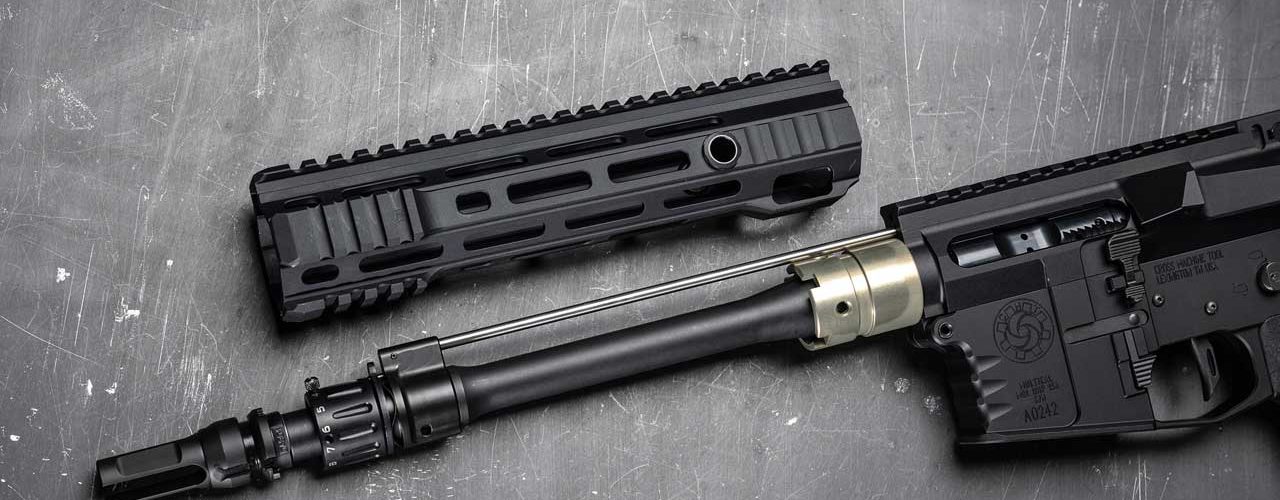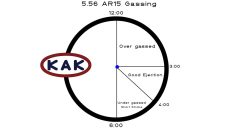Have you ever wondered how the gas system in an AR-15 works? Whether you’re an experienced shooter or new to firearms, understanding the mechanics of the AR-15 gas system is essential. In this informative article, we will dive into the intricacies of the AR-15 gas system and provide you with everything you need to know.
From the gas port to the gas tube and the gas block, we will explore each component and its function within the gas system. We’ll discuss the two main types of gas systems found in AR-15 rifles – direct impingement and piston-operated – highlighting the strengths and weaknesses of each.
Additionally, we’ll cover common maintenance tips, troubleshooting techniques, and best practices to keep your AR-15 gas system running smoothly.
With this comprehensive guide, you’ll gain a deeper understanding of the AR-15 gas system, empowering you to make informed decisions when it comes to choosing, operating, and maintaining your firearm. So, let’s dive into the world of AR-15 gas systems and unlock their secrets together.
How does the AR-15 gas system work?
The AR-15 gas system is a critical component that enables the rifle to function reliably and efficiently. When the rifle is fired, the explosive force of the gunpowder propels the bullet forward and also generates high-pressure gas. This gas is then directed through a small port in the barrel, known as the gas port, and into the gas tube, which is part of the upper receiver.
The gas tube carries the high-pressure gas into the gas block, which is a critical component that directs the gas to the appropriate location. In a direct impingement system, the gas is directed straight into the bolt carrier group, causing it to move rearward and cycle the action. In a piston-driven system, the gas is used to push a piston, which in turn moves the bolt carrier group.
The gas system is designed to provide just the right amount of gas to reliably cycle the action, without over-gassing the system and causing excessive wear or malfunctions. The size and placement of the gas port, as well as the length and diameter of the gas tube, all play a crucial role in the overall performance and reliability of the AR-15 gas system.
Related: What is a Bolt Carrier Group? Discover the Ins and Outs of BCGs, For an overview of all the essential parts of an AR-15, visit our guide on What are AR-15 Parts?
Different types of AR-15 gas systems
The two main types of gas systems found in AR-15 rifles are the direct impingement system and the piston-driven system. Each system has its own unique characteristics and advantages, and the choice between the two often comes down to personal preference and the intended use of the rifle.
The direct impingement system is the original design used in the AR-15 platform. In this system, the high-pressure gas is directed straight into the bolt carrier group, causing it to move rearward and cycle the action. This design is relatively simple and lightweight, making it a popular choice for many shooters.
The piston-driven system, on the other hand, uses a gas piston to transfer the energy from the gas to the bolt carrier group. Instead of the gas being directed straight into the bolt carrier, it pushes a piston, which in turn moves the bolt carrier group. This design is often touted as being more reliable and cleaner-running than the direct impingement system, as the bolt carrier group is not directly exposed to the hot, fouling gases.
Different types of AR-15 gas systems
The two main types of gas systems found in AR-15 rifles are the direct impingement system and the piston-driven system. Each system has its own unique characteristics and advantages, and the choice between the two often comes down to personal preference and the intended use of the rifle.
The direct impingement system is the original design used in the AR-15 platform. In this system, the high-pressure gas is directed straight into the bolt carrier group, causing it to move rearward and cycle the action. This design is relatively simple and lightweight, making it a popular choice for many shooters.
The piston-driven system, on the other hand, uses a gas piston to transfer the energy from the gas to the bolt carrier group. Instead of the gas being directed straight into the bolt carrier, it pushes a piston, which in turn moves the bolt carrier group. This design is often touted as being more reliable and cleaner-running than the direct impingement system, as the bolt carrier group is not directly exposed to the hot, fouling gases.
Pros and cons of direct impingement system
The direct impingement system has several advantages that have made it a popular choice among AR-15 owners. One of the primary benefits is its simplicity and lightweight design. The lack of additional moving parts, such as a piston, makes the direct impingement system relatively easy to maintain and less prone to mechanical issues.
Additionally, the direct impingement system is generally more accurate than the piston-driven system, as the bolt carrier group is able to move more freely and with less resistance. This can be particularly beneficial for precision shooting applications, where accuracy is of the utmost importance.
However, the direct impingement system also has some drawbacks. Because the hot, fouling gases are directed straight into the bolt carrier group, this system can be more prone to carbon buildup and fouling, which can lead to increased maintenance requirements and potential malfunctions if not properly cleaned and lubricated.
Pros and cons of piston-driven system
The piston-driven system offers several advantages over the direct impingement system. One of the primary benefits is its improved reliability and cleaner operation. By using a gas piston to transfer the energy from the gas to the bolt carrier group, the piston-driven system is less prone to carbon buildup and fouling, as the bolt carrier group is not directly exposed to the hot, fouling gases.
This can be particularly beneficial in harsh environments or when using dirtier ammunition, as the piston-driven system is generally more tolerant of such conditions. Additionally, the piston-driven system is often considered to be more durable and able to withstand more abuse than the direct impingement system.
However, the piston-driven system also has some drawbacks. The addition of the gas piston and associated components can make the overall system slightly heavier and more complex than the direct impingement system. This can impact the rifle’s balance and handling characteristics, as well as potentially reduce the overall accuracy compared to the direct impingement system.
Choosing the right gas system for your AR-15
When it comes to choosing the right gas system for your AR-15, there are several factors to consider. The intended use of the rifle, the environment in which it will be used, and your personal preferences and shooting style all play a role in determining the best gas system for your needs.
If you prioritize reliability, cleanliness, and the ability to withstand harsh conditions, the piston-driven system may be the better choice. This system is generally more tolerant of fouling and can be a good option for those who plan to use their AR-15 in dusty, dirty, or wet environments.
On the other hand, if you value simplicity, lightweight design, and maximum accuracy, the direct impingement system may be the better fit. This system is often preferred by competitive shooters and those who prioritize precision over other factors.
Upgrading your AR-15 gas system
Upgrading the gas system on your AR-15 can be a great way to improve the overall performance and reliability of your rifle. Whether you’re looking to switch from a direct impingement system to a piston-driven system, or simply want to fine-tune your existing gas system, there are a variety of aftermarket components and modifications available.
One common upgrade is to install a adjustable gas block, which allows you to fine-tune the amount of gas being directed to the bolt carrier group. This can be particularly helpful in mitigating over-gassing or under-gassing issues, and can help ensure that your AR-15 is cycling reliably and efficiently.
Another popular upgrade is to replace the gas tube with a higher-quality, more durable option. This can help improve the overall reliability and longevity of your gas system, and can be especially beneficial if you plan to use your AR-15 in demanding environments or under heavy use.
Maintaining and troubleshooting your AR-15 gas system
Proper maintenance and troubleshooting of your AR-15 gas system is essential for ensuring reliable and consistent performance. Regular cleaning and lubrication of the gas system components, such as the gas block, gas tube, and bolt carrier group, can help prevent the buildup of carbon and fouling, which can lead to malfunctions and reduced accuracy.
In the event of a gas system-related issue, such as a failure to cycle or excessive recoil, it’s important to carefully inspect the components and identify the root cause. This may involve checking for obstructions in the gas port or gas tube, ensuring the gas block is properly aligned and secured, or verifying that the gas system is receiving the appropriate amount of gas.
If you’re unsure about how to properly maintain or troubleshoot your AR-15 gas system, it’s always a good idea to consult with a qualified gunsmith or refer to the manufacturer’s instructions. Taking the time to understand and properly care for your gas system can help ensure the long-term reliability and performance of your AR-15.
Common misconceptions about AR-15 gas systems
Despite the wealth of information available about AR-15 gas systems, there are still several common misconceptions that persist among gun owners and enthusiasts. One of the most prevalent is the idea that the piston-driven system is inherently more reliable than the direct impingement system.
While the piston-driven system can offer improved reliability in certain situations, such as when using dirtier ammunition or operating in harsh environments, it’s not necessarily a universal solution. Both gas systems can be highly reliable when properly maintained and operated within their design parameters.
Another misconception is that the gas system is the primary factor in determining the accuracy of an AR-15. While the gas system can play a role in overall accuracy, factors such as the barrel, trigger, and ammunition selection are often more significant contributors to the rifle’s precision.
Conclusion
The AR-15 gas system is a critical component that plays a vital role in the reliable and efficient operation of the rifle. Whether you prefer the simplicity and lightweight design of the direct impingement system or the improved reliability and cleanliness of the piston-driven system, understanding the intricacies of the gas system is essential for getting the most out of your AR-15.
By familiarizing yourself with the different types of gas systems, their respective pros and cons, and the proper maintenance and troubleshooting techniques, you’ll be better equipped to choose the right gas system for your needs and keep your AR-15 running at its best. With this knowledge in hand, you can confidently explore the world of AR-15 gas systems and unlock the full potential of your rifle.




Add comment